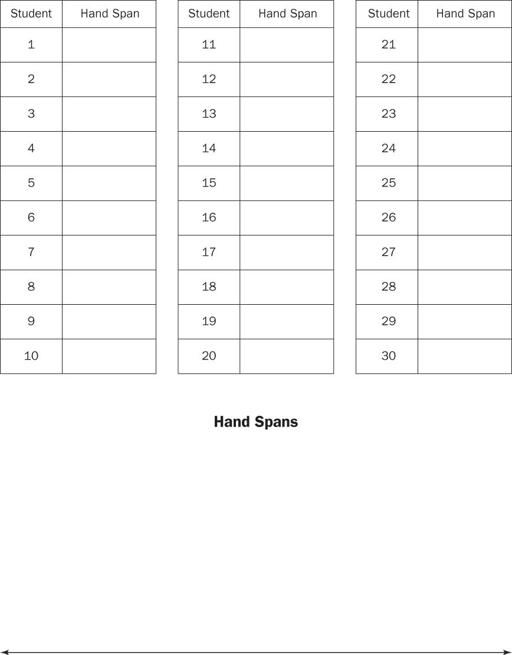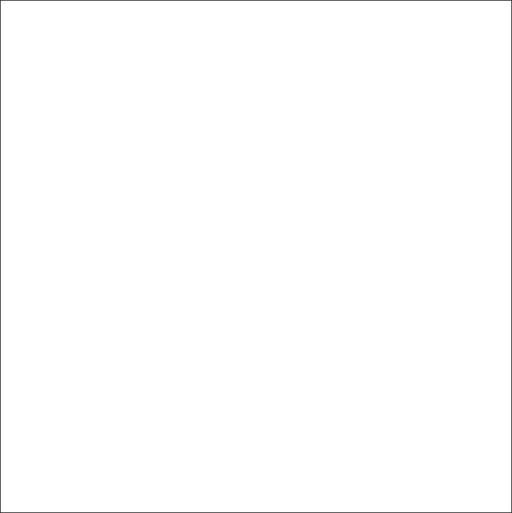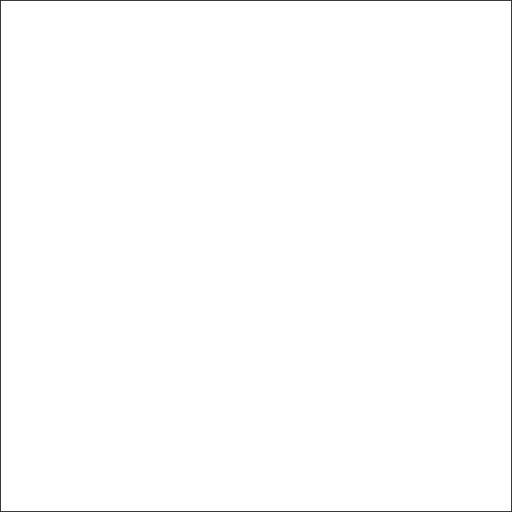Teaching the Common Core Math Standards With Hands-On Activities, Grades 3-5 (17 page)
Read Teaching the Common Core Math Standards With Hands-On Activities, Grades 3-5 Online
Authors: Judith A. Muschla,Gary Robert Muschla,Erin Muschla-Berry
Tags: #Education, #Teaching Methods & Materials, #Mathematics, #General

Closure
Discuss the line plots. Ask your students question such as: What was the most common hand span in the class? What was the least common? Is a line plot a good tool for displaying data? Why?
Names ______________________________________ Date
____________
Hand Span Data Sheet
Measurement and Data: 3.MD.5
“Geometric measurement: understand concepts of area and relate area to multiplication and to addition.”
5. “Recognize area as an attribute of plane figures and understand concepts of area measurement.
a.
“A square with side length 1 unit, called ‘a unit square,’ is said to have ‘one square unit’ of area, and can be used to measure area.
b.
“A plane figure which can be covered without gaps or overlaps byunit squares is said to have an area of
square units.”
Background
The area of plane figures can be measured by covering the figure with square units. Covering a plane figure with square units can help students recognize area.
Activity: Covering the Area
Working in groups, students will cover a 1-foot square with 1-inch square tiles.
Materials
About 150 1-inch square tiles; large construction paper (12 inches by 18 inches); rulers with a 1-inch scale; scissors for each group of students.
Procedure
1.
Explain that area is the number of square units needed to cover a surface. For this activity students will cover a surface with square units to find the area of the surface.
2.
Instruct your students to use their rulers to accurately measure a square with sides of 1 foot (12 inches) on their paper. If they are using paper that is 12 inches by 18 inches, they can do this by taking the paper lengthwise and measuring 6 inches along one side. Tell them to mark a point 6 inches from the short edge at the top of the sheet and a point 6 inches from the short edge at the bottom. Drawing a straight line connecting these two points should result in a 1-foot square on their paper. Demonstrate how they should do this.
3.
After students have drawn their square, instruct them to cut along the line that they drew. They should now have a 1-foot square.
4.
Explain that they are now to use their 1-inch square tiles to cover the area of their 1-foot square. Each tile should be placed so that its edges neatly fit against the other tiles around it. The tiles should completely cover the 1-foot square without leaving any gaps or overlaps.
Closure
Discuss your students' covered squares. How many 1-inch squares were required to cover the 1-foot square? Emphasize that the 1-foot square is covered with 144 1-inch squares, meaning it has an area of 144 square inches.
Measurement and Data: 3.MD.6
“Geometric measurement: understand concepts of area and relate area to multiplication and to addition.”
6. “Measure areas by counting unit squares (square cm, square m, square in, square ft, and improvised units.)”
Background
The area of a plane figure can easily be measured by counting square units. The number of square units equals the area of the figure.
Activity 1: Measuring Areas
Students will measure the area of flat surfaces by counting unit squares.
Materials
Scissors; rulers with centimeter and inch units; reproducibles, “5-Inch Square” and “10-Centimeter Square,” for each student.
Procedure
1.
Hand out copies of the reproducibles. Explain that students are to cut out the 5-inch square and 10-centimeter square.
2.
Explain that they are to measure each square with their rulers and decide how the surface of the paper can be divided into square units.
3.
Explain that after students have determined what square units each large square can be divided into, they should use rulers to draw square units on the paper. Next they should count the total number of square units needed to cover the surface of each square without any gaps or overlaps.
Closure
Discuss students' results. The square with sides of 5 inches can be divided into 1-inch square units and has an area of 25 square units. The square with sides of 10 centimeters can be divided into 1-centimeter square units and has an area of 100 square centimeters.
Activity 2: Measuring Areas with Appropriate Tools
Working in small groups, students will measure areas with unit squares.
Materials
Meter sticks; yard sticks; 1-foot rulers with inch and centimeter scales for each group; masking tape for the teacher.
Preparation
Before students enter the classroom, measure various rectangles and squares on the classroom floor and mark the corners of the figures with masking tape, for example a 2-meter-by-1-meter rectangle, a 2-yard square, and a 4-foot square. Also designate the surfaces of various objects such as desks, tables, bulletin boards, books, windowsills, and the door to the classroom for measurement. Be sure to find the areas of these figures prior to the activity.
Procedure
1.
Explain to your students that they will be using meter sticks, yard sticks, and rulers to find the areas of various figures. Remind them that areas are measured in square units.
2.
Show your students the figures that they will be measuring. Tell them that they will need to use the appropriate tool—a meter stick, yard stick, or ruler (in inches or centimeters)—to find as closely as possible the number of unit squares that will cover each particular figure, without any gaps or overlaps.
3.
Instruct groups to designate a recorder who will write down the number of square units needed to cover each figure.
4.
To avoid congestion and idle “waiting around,” have groups work at different parts of the classroom, measuring different figures.
5.
Remind students that they should try to be as accurate as possible in measuring and then counting the number of unit squares they find in each figure.
Closure
Discuss your students' results. Which group's results were closest to the actual area of each figure? What, if any, problems did students have in measuring the figures? How did they resolve the problems? Emphasize that the area of a plane figure can always be found by counting the unit squares that cover the area completely.
5-Inch Square
10-Centimeter Square



